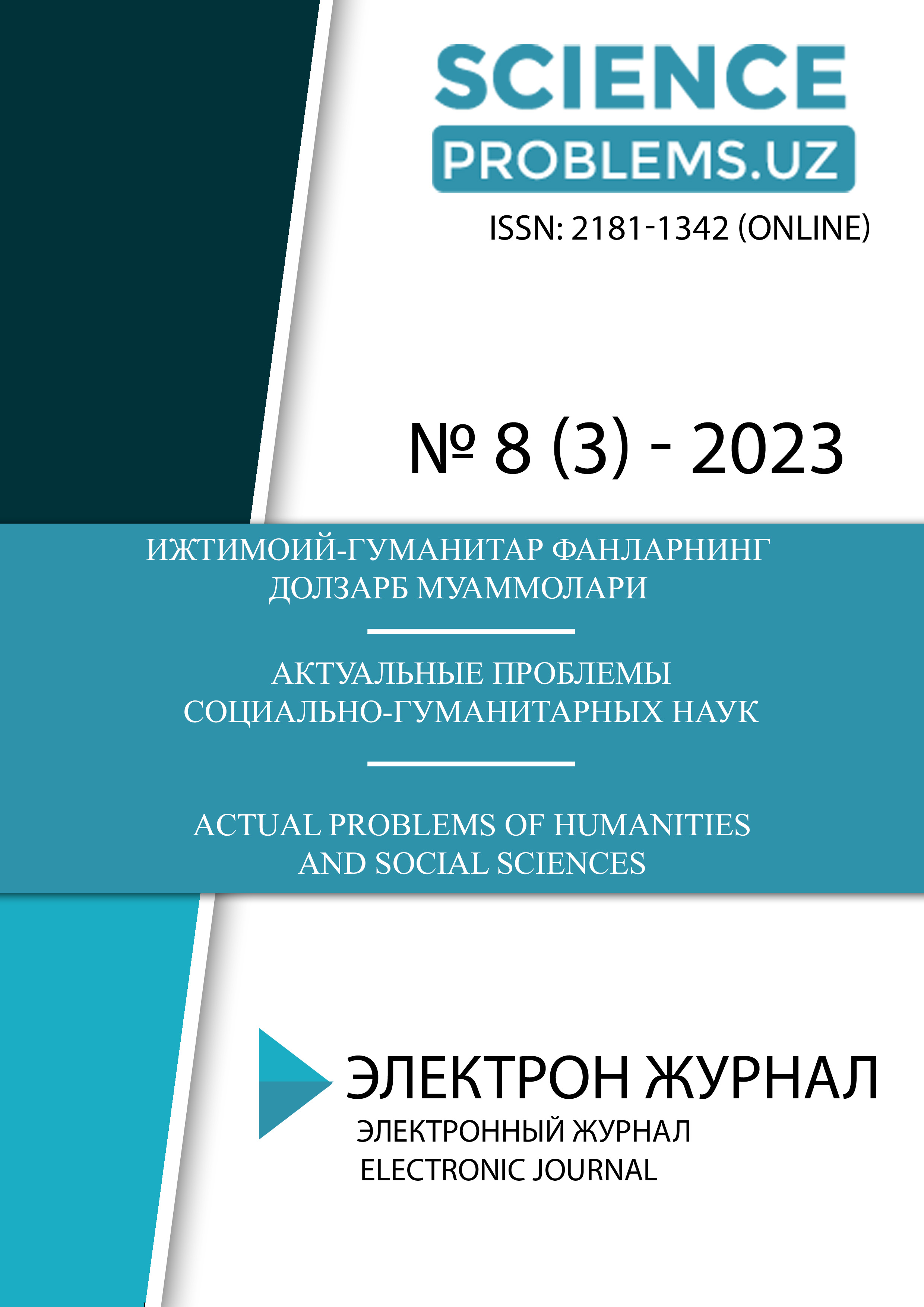JEYMS MAKKROSKINING ONA (BIRINCHI) TIL KONTEKSTIDA MULOQOT QILISHGA TAYYORLIK HAQIDAGI TADQIQOTINI O'RGANISH: TILNI O'QITISH VA O'RGANISHGA JALB QILISH
DOI:
https://doi.org/10.47390/SCP1342V3I8Y2023N56Kalit so'zlar:
Jeyms Makkroski, muloqotdan qo'rqish, muloqot qilishga tayyorlik, ona tilning kontekstlari, tilni o'rgatish va o'rganish.Annotatsiya
Ushbu maqolada Jeyms Makkroskining muloqotga tayyorlik va uning muloqotdan qo'rqish bilan aloqasi haqidagi tadqiqotlari haqida umumiy ma'lumot berilgan. Xususan, maqola Makkroskining L1 kontekstlarida muloqot qilishga tayyorligi haqidagi tadqiqotlariga, shu jumladan uning ushbu konstruktsiyaga ta'sir etuvchi omillar va uning til bilimi bilan aloqasi haqidagi xulosalariga qaratilgan. Maqolada, shuningdek, McCroskey tadqiqotining kelajakdagi tadqiqotlar uchun potentsial yo'nalishlar belgilanadi. Umuman olganda, maqola turli til va madaniy kontekstlarda muloqot qilish istagini tushunish muhimligini va uning tilni o'rgatish va o'rganish uchun potentsial oqibatlarini ta'kidlaydi.
Foydalanilgan adabiyotlar
Beatty, M. J., & McCroskey, J. C. (2009). The relationships among teacher immediacy behaviors, student motivation, and learning. Communication Education, 58(3), 365-381.
Burgoon, J. K. (1976). The role of affect in communication. In C. D. Spielberger & I. G. Sarason (Eds.), Stress and anxiety (Vol. 3, pp. 183-207). Hemisphere Publishing.
Burroughs, N. F., Marie, E. L., & McCroskey, J. C. (2003). Relationships of self-perceived communication competence and communication apprehension with willingness to communicate: A comparison with first and second languages in Micronesia. Communication Research Reports, 20(3), 255-262.
Horwitz, E. K., Horwitz, M. B., & Cope, J. (1986). Foreign language classroom anxiety. The Modern Language Journal, 70(2), 125-132.
Jung, H. Y. & McCroskey, J.C. Communication Apprehension in a first language and self-perceived competence as predictors of communication apprehension in a second language: A study of speakers of English a as second language. Communication Quarterly. Vol. 51, No 2
Lin, W. C., Chen, H. C., & Chen, C. H. (2021). The effects of online writing software on the writing performance and willingness to communicate of EFL learners. Journal of Educational Computing Research, 59(2), 275-292.
Liu, J. (2019). Classroom interactional competence and willingness to communicate: A study of Chinese EFL learners. Journal of Multilingual and Multicultural Development, 40(7), 600-614.
Liu, J., & Jackson, J. (2008). An exploration of Chinese EFL learners’ unwillingness to communicate and foreign language anxiety. The Modern Language Journal, 92(1), 71-86.
Liu, M., & Zhang, L. (2013). The relationship between Chinese EFL learners’ anxiety and their beliefs about English learning. System, 41(1), 87-97.
MacIntyre, P. D., & Gardner, R. C. (2002). "Affective and motivational predictors of adaptive learning among individualistic and collectivistic learners in Canada and Japan." Journal of Cross-Cultural Psychology, 33(3), 260-277.
MacIntyre, P. D., Baker, S. C., Clément, R., & Donovan, L. A. (1999). "Sex and age differences in willingness to communicate, communication apprehension, and self‐perceived competence." Communication Research Reports, 16(4), 420-427.
MacIntyre, P. D., Noels, K. A., & Clément, R. (1998). "Biases in self-ratings of second language proficiency: The role of language anxiety." Language Learning, 48(3), 43-63.
McCroskey, J. C. (1992). Reliability and validity of the willingness to communicate scale. Communication Quarterly, 40(1), 16-25.
McCroskey, J. C. (1997). Willingness to communicate, communication apprehension, and self-perceived communication competence: Conceptualizations and perspectives. In J. A. Daly, J. C. McCroskey, J. Ayres, T. Hopf, & D. M. Ayres (Eds.), Avoiding communication: Shyness, reticence, & communication apprehension (pp. 13-29). Hampton Press.
McCroskey, J. C. (n.d.). Brief biography. James C. McCroskey. Retrieved July 12, 2023, from http://www.jamescmccroskey.com/briefbio.htm
McCroskey, J. C., & Baer, E. (1985). Willingness to communicate: The construct and its measurement. Communication Monographs, 52(3), 251-275.
McCroskey, J. C., & McCroskey, L. L. (2002). Willingness to communicate and communication apprehension. In R. Chesebro & J. C. McCroskey (Eds.), Communication for teachers (pp. 121-136). Allyn & Bacon.
McCroskey, J. C., & Richmond, V. P. (1987). Willingness to communicate. In J. A. Daly & J. C. McCroskey (Eds.), Personality and interpersonal communication (pp. 129-156). SAGE Publications.
McCroskey, J. C., & Richmond, V. P. (1990). Willingness to communicate: A cognitive review. Journal of Special Behavior and Personality, 5(2), 1-25.
McCroskey, J. C., and Richmond, V.P. (1998). Willingness to Communicate. J.C. McCroskey, J.A. Daly, M.M. Martin, & M.J. Beatty, (Eds.), Communication and Personality, (pp. 119-131). Cresskill, NJ: Hampton Press.
McCroskey, J.C., and Beatty, M.J. (1998). Communication Apprehension. J.C. McCroskey, J.A. Daly, M.M. Martin, & M.J. Beatty, (Eds.), Communication and Personality, (pp. 215-231). Cresskill, NJ: Hampton Press.
Neuliep, J. W., Chadouir, M. & McCroskey, J. C. (2003) A Cross cultural test of association between temperament and communication apprehension. Communication research reports. Vol. 20. No 4
Peng, J. E. (2014). Willingness to communicate in Chinese EFL classroom contexts: An ecological perspective. System, 46, 20-31.
Pragash, K. V. (2020). Willingness to communicate in the first language: A review of literature. The Journal of Language Teaching and Learning, 10(1), 34-46. doi: 10.1558/jltl.v10i1.69787
Riasati, M. J., & Rahimi, A. (2018). Willingness to communicate across gender, age, and socioeconomic status: A study of Iranian EFL learners. Journal of Language and Education, 4(2), 24-43.
Richmond, V. P., & McCroskey, J. C. (1989). Willingness to communicate and dysfunctional communication processes. In G. R. Miller & B. M. Montgomery (Eds.), Interpersonal communication processes (pp. 63-81). SPECTRA Inc.
Sallinen-Kuparinen, A., McCroskey, J. C., & Richmond, V. P. (1991). Willingness to communicate, communication apprehension, introversion, and self-perceived communication competence: Finnish and American comparison. Communication Research Reports, 8, 55-64.
Warschauer, M. (2010). New technologies and learning environments for language teaching. Language Teaching, 43(02), 155-168.
Zakahi, W. R., & McCroskey, J. C. (1989). Willingness to communicate: A potential confounding variable in communication research. Communication Quarterly, 37(4), 297-308.
Zhang, Y., & Hu, G. (2009). A comparative study of Chinese EFL learners’ and English native speakers’ perceptions of pragmatic appropriateness. System, 37(2), 205-217.
Zhang, Y., Lin, C. H., & Zhang, J. (2014). Willingness to communicate in English: A microsystem model in Chinese EFL classrooms. System, 42, 90-102.









